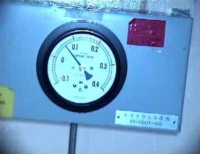Reinforcement is planned for sea defence at Fukushima Daiichi, as well as for the fuel pond in unit 4.
 |
| Robots have crept into the damaged Fukushima reactor buildings. Here one takes a look at the containment pressure gauge of unit 1 |
Tokyo Electric Power Company (Tepco) said the structure of the damaged unit 4 reactor building could still withstand an earthquake of the same magnitude as struck on 11 March, but the reinforcement will give an additional safety margin.
Tepco said preparation to do this work would start soon, the steel column should be in place by the middle of June with the work completed by the end of July.
The exact cause of damage to unit 4 is not officially noted by the Nuclear and Industrial Safety Agency (Nisa). Spontaneous fires in the area of the ponds were seen on 15 March but these went out without intervention. The building seems to have suffered a hydrogen explosion, but it is possible
Radiation control
Exhaust fans are being installed in unit 1 with the aim of reducing radioactivity in the air to 5% of current levels. Robotic inspections have shown general dose rates in unit 1 of between 10 and 49 millisieverts per hour but with one zone noted to be as high as 1100 millisieverts per hour.
A second female worker has been assessed as receiving over the regulation 5 millisieverts per three-month period. Effective exposure calculations show this worker received 7.49 millisieverts. |
Other protection work in preparation concerns the sea defences that were found lacking in the face of the 11 March tsunami. Aftershocks continue to hit Japan and some as large as magnitude eight are predicted, with a corresponding risk of tsunami.
A temporary coastal levee will be built to protect the site against inundation of up to four metres on the sea side and ten metres near units 3 and 4. This compares to the flooding on site that reached about five metres in depth around the reactors on 11 March. Tepco said it had also relocated diesel generators to higher ground. Flooding of these in their original location was a major factor in three reactors and four fuel ponds overheating.
Measures such as these will be essential for the site to be considered fully stabilised in future so that emergency precautions can be lifted and people may return to their homes.
Researched and written
by World Nuclear News





_18570.jpg)
_16159.jpg)
_49205.jpg)





